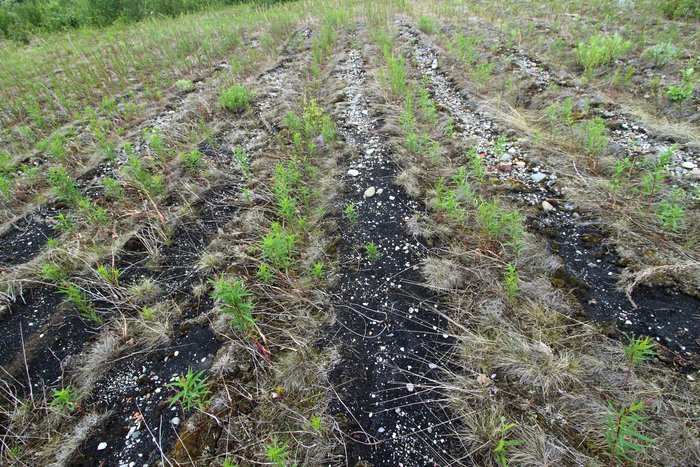
When mining is completed, coal mines are required to be reclaimed to standards defined by the state and federal government. Reclamation can be a major issue in mine proposal controversies (such as Chuitna), where mine opponents argue that valuable habitat is impossible to reclaim, and mine proponents argue that reclamation will be successful.
Reclamation standards at Usibelli Coal Mine Inc., Alaska’s only operating coal mines, include replacing topsoil and establishing vegetation cover to prevent erosion. Wildlife habitat is designated as the “post-mining land use.” It is difficult to assess the potential for reclamation, since there is little data on the success or failure of coal mine reclamation techniques, particularly in restoring streams and wetlands.
Reclamation of streams and wetlands

Some coal deposits, such as at the proposed Chuitna Mine, occur beneath wetlands and streams. Dr. Margaret Palmer at the University of Maryland has written a report highlighting the potential difficulties in restoration of these areas.
Most stream restoration science deals with the modification of existing channels - the science of recreating a mined-through stream from scratch is untested. Wetland and peatland reclamation is also problematic, since natural peat takes thousands of years to form. Science on peatland restoration is sparse, but suggests that for success the site would need to begin with some remnant vegetation, a seed bank in the soil, and connection to other healthy peatlands - unlikely in a strip-mined area. Wetland restoration is much better studied. However, full ecological restoration is difficult and rarely achieved, especially when the hydrological flow paths have been disrupted.
Federal Regulations
The environmental reclamation of coal mining sites is controlled by the federal government through the Surface Mining Control and Reclamation Act of 1977 which is regulated by the Office of Surface Mining Reclamation and Enforcement (OSMRE). This law created two programs, one for regulating active coal mines and one for reclaiming abandoned mines for whom no party could be held legally responsible (such as when the mining company has gone bankrupt). The OSMRE requires publicly available annual updates on all reclamation projects and problems within each state (for example the annual update for Alaska). These programs are funded by a tax on coal mining operations which is 35 cents per ton on surface mining operations and 10 cents per ton on underground mining operations. For comparison, coal typically wholesales for $10-$100 per ton. In addition, current mines are required to post a bond that covers the theoretical cost of reclamation at that site, in case the company goes out of business before reclamation is complete. However, some environmental groups have recently questioned the efficacy of this program and the success of coal mine reclamation in general.
The Abandoned Mine Land (AML) program originally dealt with coal mines abandoned before 1977 but was later modified to be applicable to mines abandoned later as well as to any type of mine. Half of the money collected in each state with an active reclamation program is given to that state and the other half is maintained in a federal emergency response fund and fund for states with no active reclamation program. Some states, such as Alaska, qualify for a “minimum program fund distribution” which means Alaska will recieve around $3 million from the AML program for FY2012

Alaska Regulations
Like many states, Alaska has its own additional reclamation program which is known as the Alaska Surface Coal Mining Control & Reclamation Act, passed into law in 1983. This act contains the detailed requirements for adequate mine reclamation as defined by the state. The law also dictates that the reclamation bonds can be released back to the mine operator in three stages. The first bond increment is released after the area is back-filled and graded to the approximate pre-mining contour, the second increment is released when the area is replanted, and the third is released at least 10 years later if the area meets the defined reclamation standards.
Usibelli Coal Mine Inc. is the only operating coal mine in Alaska and has pledged around $3 million for reclamation of the Gold Run Pass and Poker Flats mines near Healy. Coal mine reclamation is in progress for some older mines, including the Jonesville mine, Suntrana Mine, and some abandoned mines in the Matanuska valley. These reclamation projects range from removing old equipment to covering open mine shafts to putting out uncontrolled coal fires.

Reclamation Process
One of Usibelli’s coal mines is in the Two Bull Ridge area. Reclamation standards for vegetation have been defined for this site, which is outlined here as an example of reclamation in Alaska. As stated in the permit, wildlife habitat is the goal for post-mining land use, and the primary objective of the reclamation plan is to encourage natural revegetation. The series of reclamation steps are as follows:
- Reclamation begins with replacing the topsoil.
- Grasses are planted (both native and non-native), and the land is fertilized.
- Native woody shrubs and trees are planted in clumps.
- Additional shrubs and woody species will be planted along two riparian areas.
Created: Jan. 19, 2018